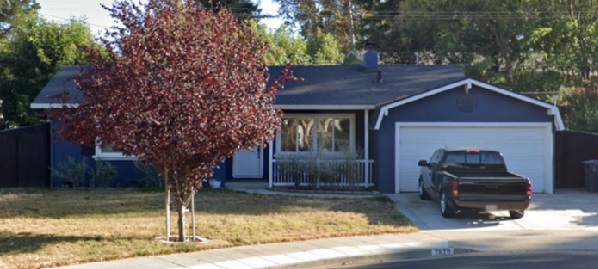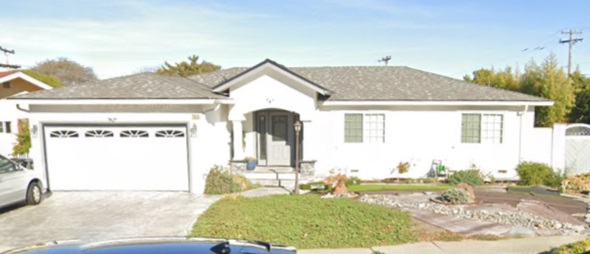San Ramon Village: Dublin’s first dream homes
Once upon a freeway crossroads—where the future highways to San Francisco and San Jose were still just lines on planning maps—a new vision for suburban living took root. In 1960, San Ramon Village became the very first subdivision in what would soon grow into the thriving city of Dublin, California.
Developed by Volk-McLain, San Ramon Village wasn't just a housing tract—it was a beginning. This charming neighborhood marked the dawn of mass-produced homes in Dublin and laid the foundation for an entire master-planned community that would proudly share its name.
 |
| Location of the San Ramon Village neighborhood in Dublin, California. |
A village begins
On Labor Day weekend, 1960, San Ramon Village opened its doors to eager homebuyers. By November, the first residents had moved in, proudly calling the village home. With its promise of quiet streets, mountain views, and modern conveniences, it quickly captured the imagination of young families chasing the American Dream.
Nestled between Alcosta Boulevard and Amador Valley Road, the neighborhood’s location was no accident—it sat strategically at the junction of future freeways, making it ideal for commuters and dreamers alike.
 |
| From a 1960 San Francisco Chronicle ad—4,000 acres of peaceful countryside that could be your new home. |
Homes with heart
The homes were designed by architect Raymond Dean Conwell, AIA (1925–1965), who infused each with both practicality and charm. Features included thermostatically controlled heating, acoustical ceilings, and diamond-pane windows that sparkled in the California sun. Stylish wallpaper added flair, while thoughtful floor plans made daily life a little easier.
With prices starting at just $13,995, San Ramon Village offered first-time buyers something nearly magical: modern homes at an accessible price.
Plans, models & styles
Volk-McLain built five main floor plans—labeled simply as Plans D, E, J, L, and M—but offered a variety of exterior designs with names like The Hacienda, The Cape Cod, or The New Orleans. Some were classic ranch or colonial, others tropical modern, and all brought their own character.
Interestingly, while most developers gave new floor plans creative names, Volk-McLain did the reverse—“new models” were usually just new exterior facades on existing layouts, leading to some playful confusion on model tour days!
A few fan favorites
The Hacienda (Plan D-1): A cozy 3-bed, 2-bath with colonial flair and stone accents.
 |
| From a 1960 San Francisco Chronicle ad—close up detail of The Hacienda with its window coverings and unique roof trim. |
The Waikiki (Plan D): A rare “tropical modern” home with bold window treatments—few were built, and fewer remain.
 |
| From a 1960 Oakland Tribune ad—the original Waikiki model in all its tropical modern glory. |
 |
| The epitome of perfection. The last surviving intact Waikiki before it was remodeled. |
The New Orleans (Plan E-7): A French Colonial with charming wrought ironwork.
 |
| From a 1961 Oakland Tribune ad—artist's rendering of the smartly designed New Orleans elevation. |
San Ramon Village model homes
At the model complex on Hillrose Drive and Donohue, paths wound through the backyards, inviting prospective homeowners to imagine a life of neighborhood barbecues and backyard games. The original showcase featured eight models, growing to twelve by year’s end.
 |
| Site of the San Ramon Village model homes. |
1. The Bel Aire (Plan J-?) - 4 bedrooms, 2 bathrooms, 1,338 - 1345 sq. ft.
 |
| The original Bel Aire model today. |
2. The Ranchero (Plan E-?) - 3 bedrooms, 2 bathrooms, 1,116 sq. ft.
 |
| The original Ranchero model today. |
3. The Hacienda (Plan D-1) - 3 bedrooms, 2 bathrooms, 1,038 sq. ft.
 |
| The original Hacienda model today. |
4. The Farmhouse (Plan E-7) - 3 bedrooms, 2 bathrooms, 1,116 sq. ft.
 |
| The original Farmhouse model today. |
5. The Cape Cod (Plan J-3) - 4 bedrooms, 2 bathrooms, 1,338 - 1345 sq. ft.
 |
| The original Cape Cod model today. |
6. The Mount Vernon (Plan E-?) - 3 bedrooms, 2 bathrooms, 1,080 – 1,116~ sq. ft.
 |
| The original Mount Vernon model today. |
7. The Waikiki (Plan D-?) - 3 bedrooms, 2-bathrooms, 1,038 sq. ft.
 |
| The original Waikiki model today. Adornments sadly removed. |
8. The New Orleans (Plan E-7) - 3 bedrooms, 2 bathrooms, 1,080 – 1,116~ sq. ft.
 |
| The original New Orleans model today. Completely renovated. |
If you preferred a Cape Cod exterior, you could choose The New England (E-8). It wasn't shown in the model complex.
 |
| The New England in its heyday. |
9. The Westerner (Plan J-?) - 4 bedrooms, 2 bathrooms, 1,338 - 1345 sq. ft.
 |
| The original Westerner model today. |
10. The San Ramon (Plan M-1) - 3 bedrooms, 2 bathrooms, 1,424 sq. ft.
 |
| The original San Ramon model today. |
If you preferred a contemporary exterior, you could choose the The Palm Springs (M-?). It wasn't shown in the model complex.
 |
| The Palm Springs in its heyday. |
11. The Southerner (Plan L-7) - 4 bedrooms, 2 bathrooms, 1,475 sq. ft.
 |
| The original Southerner model today. Completely renovated. |
12. The Suburban (Plan L-1) - 4 bedrooms, 2 bathrooms, 1,475 sq. ft.
 |
| The original Suburban model today. Completely renovated. |
If you preferred a contemporary exterior, you could choose The Westwood (L-?). It was released in Unit 5 and wasn't shown in the model complex.
Buildout and pricing
Between 1960 and 1961, 874 homes were constructed in five phases, or “units.” The bulk of construction took place in 1960 (650 homes), with the final batch—Unit 5—released in early 1961 (234 homes), offering subtle style enhancements. Pricing rose slightly as demand grew:
- 1960: $13,995 +
- 1961: $14,995 +
- 1962: $14,995 +
After wrapping up San Ramon Village, Volk-McLain expanded their vision, building nearby neighborhoods like Country Club Park, Barkley Square, and Brighton Circle, each tailored to different lifestyles and budgets.
A lasting legacy
Though many of the original facades have been remodeled or modernized, the heart of San Ramon Village remains. The neighborhood’s prime location, thoughtful layout, and role as Dublin’s first true subdivision have ensured its place in local history.
San Ramon Village was more than just the first development in Dublin—it was where the city’s suburban story began. With every floor plan, every pathway, and every white picket fence, a little piece of the American Dream took shape.
Related post: Volk-McLain's San Ramon Village



Comments
Post a Comment